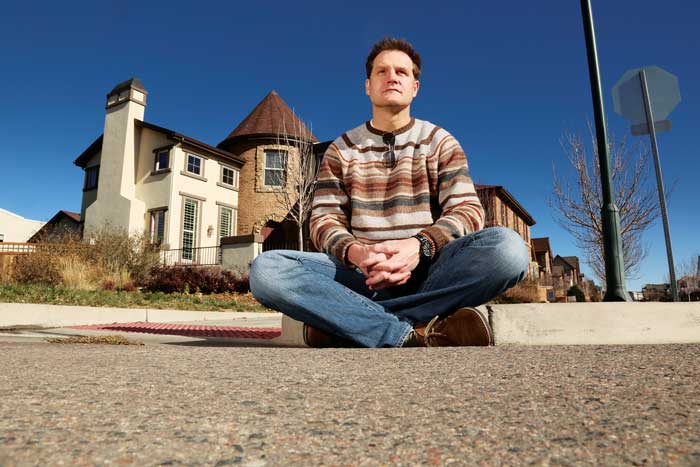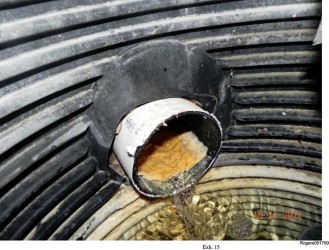
Tad Rogers sits outside his house in Stapleton.
“Whatever you do, this problem is going to exist,” says Stapleton resident Tad Rogers, who recently received a judgment from a jury trial that included $242,000 to replace his clogged drainage pipes and $552,000 for the hassles and inconvenience he has experienced in dealing with the drainage problems. The only real solution, he says, is something that’s not feasible—a “de-watering well” that would pump out the groundwater under his home. Or a historic drought like the one when the original groundwater testing was done in 2001/02.
Rogers says his sump pump runs every six minutes—and if his sump pump stopped working the basement would flood quickly. He paid for an extra high basement ceiling when he bought the house in 2006—but now, he says, the level of moisture in his basement slab is too high to put a floor covering on it. A groundwater test in 2011 showed the water table at his house was at seven feet—and his basement is 10-11 feet underground.
In 2008, when Rogers first became aware that his sump pump was running almost continuously, he discovered that the water was being discharged near his house, where it soaked into the ground and re-entered the drainage system. He solicited help from Forest City and from his builder, Infinity. Infinity responded and changed how his sump pump discharges so it goes into the city’s storm water system (city permits are required for this) and not into his yard.

Calcite is visible in Rogers’ sump pump pit both in the bottom of the pipe and along the wall of the pit. Photo by Hayes Consulting.
That piece of the problem was solved, but a new issue was discovered. A camera inserted into Rogers drainage pipes revealed that calcite from the groundwater is forming a coating within his drainage pipes. The pipes, which are built into the perimeter of the foundation, have holes so any groundwater at the foundation will flow into the pipes and be carried by gravity to the sump pump. With the intake holes in the drainage pipes getting clogged, less water will flow in, and the drainage system designed to protect the foundation of his house will become less and less effective.
Rogers sued Forest City—and a key question in the suit hinged on the source of the calcite clogging his drainage system.
The geotechnical report* obtained by Rogers’ lawyers said, “The primary source of the calcite is the recycled concrete aggregate base course placed below the pavements.” He further stated that water can escape from the pavement through sub-grade percolation and through pavement cracks and joints. The report cites a 1997 study that showed recycled concrete as pavement base was the cause of calcite accumulation in pavement sub-drainage systems and foundation drain systems, and states this is the reason some states don’t allow recycled concrete to be used as a road base. His report also says that as the roads get older the calcite leaching problem will only get worse.
His recommended fix for the problem is to shore up the foundation, remove the basement slab, install new drainage pipes, build a sub-basement crawl space that has access to the drainage pipes so they can be accessed and replaced as needed due to future build-up (projected to be every 6-8 years), and build a structural basement floor that does not rest on the ground, with a moisture barrier beneath it.
The Front Porch asked Forest City if they were aware of reports from the late 80s and 90s about calcite leaching from recycled concrete used in road bases. Hubert Farbes, attorney for Forest City, provided their response to these studies. “Forest City is aware of no evidence of calcite leaching from the placement of RABC (recycled aggregate base course) in the road base used at the Stapleton development.” Farbes explained that, while earlier studies have shown calcite leaching occurred when RABC was used in a wet, or drained environment (“drained

A video camera inserted in Rogers drainage pipe shows the accumulation of calcite that is coating the inside and clogging the holes at the bottom of the pipe. The holes are designed to let excess water seep into the pipe and get carried by flow of gravity to the sump pump. Photo by Hayes Consulting
pavements”), recycled concrete is authorized for use in Denver only in dry base course pavements. These pavements are designed and constructed with the intent that the road base will remain dry, unlike drained pavements where base course is designed to drain water from the road to an outfall. Roads in the Stapleton filings, and throughout Denver, are not designed as drained pavements; and RABC is installed in Denver only as dry structural support for a road pavement. Cracks that appear (and are routinely sealed) in dry base course pavements are normal and do not create wet conditions in the road base.

An April 2000 photo shows the recycling of old runway from Stapleton airport into material used for construction at the new Stapleton development.
Farbes also said, “Forest City does not believe it is appropriate to comment publicly on a matter pending in the trial court (the Judgment and Award in this matter is not final until the trial court has ruled on outstanding motions respecting the jury verdict and award); and Forest City will not comment on the statements made to you by Plaintiff’s counsel respecting a pending court ruling.”
The plaintiff’s attorneys, Clyde Faatz and Ashleigh Mason of Hamilton Faatz PC, say that under Colorado law a home builder has an implied non-waivable warranty of habitability. They made the case that the implied warranty should extend to Forest City. As master developer, Forest City controlled what lots Infinity could buy, what model they could build, what price point homes would have, and they received a part of the gross price as a marketing fee. They have two seats on the Park Creek Metro District board, which signed the contracts for the development of the roads. Faatz points out that not all lots are suitable for having basements and Rogers’ home should not have been sold as a home with the potential for a finished basement.
Faatz says, “We asked the judge to imply a warranty from the lot developer to Mr. Rogers. If that ruling is appealed by Forest City and is upheld by the Court of Appeals or the Supreme Court of Colorado, that will be the first time, to our knowledge that the court has implied a warranty from the lot developer to the first home buyer.
“Now it’s Judge Stern’s district court ruling that other judges can follow or not follow. However once the Colorado Court of Appeals or the Colorado Supreme Court affirms that decision, then it becomes binding on all district court trial judges.”
For now, Rogers says his sump pump continues to run almost continuously and he worries about the basement flooding if the sump pump stops, though he does have an alarm that would warn him if he’s at home. All he can do is wait and see how long the existing system will keep pumping out the groundwater. At some point, the experts tell him, the drainage pipes will become fully clogged and non-functional.
*The consulting engineers were W. Matthew Hayes, PE, Hayes Consulting Company and Edward L. Fronapfel, P.E., SBSA (Solutions Before, Solutions After).



The engineers that worked on determining this issue and providing the photos above were Hayes Consulting and SBSA Inc., hcc-engineers.com and CallSBSA.com.